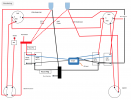SkunkBoat
GreatGrady Captain
- Joined
- Oct 12, 2017
- Messages
- 4,717
- Reaction score
- 1,663
- Points
- 113
- Location
- Manasquan Inlet NJ
- Website
- www.youtube.com
- Model
- Express 265
You read it as open or just not zero ohms? Wire does not "pass voltage" it passes current and if any current is flowing you will read some voltage
The best way to test a corroded wire is to jump it with a good wire....
fyi, my aux cables had been extended and had crimped butt connectors covered by a rubber sleeve.
I don't have my Seloc manual since I sold the motors so I don't want to talk out my ass without backup...but...
I beleive the diodes for the aux are built into the Rectifier/Regulator. In theory, difference between the charging voltage on the starting cable and the aux cable is .6 or .7 v ( the drop across a diode). Except you have a battery connected and cables and switches...
Based on your reading listed above I suspect that your stbd motor is not charging anything. I would want to rule out easy things.
I would measure the stator coil. Disconnect the green plug to the regulator and measure ohms across the 3 pins. Compare to other motor.
They should be low ohms, none should be open.
Without a manual I would not presume to tell you how to test the regulator for spec voltage out at spec rpm.
I'm not sure about your port motor. When you revved the motor did the 10v rise up to 14v?
The best way to test a corroded wire is to jump it with a good wire....
fyi, my aux cables had been extended and had crimped butt connectors covered by a rubber sleeve.
I don't have my Seloc manual since I sold the motors so I don't want to talk out my ass without backup...but...
I beleive the diodes for the aux are built into the Rectifier/Regulator. In theory, difference between the charging voltage on the starting cable and the aux cable is .6 or .7 v ( the drop across a diode). Except you have a battery connected and cables and switches...
Based on your reading listed above I suspect that your stbd motor is not charging anything. I would want to rule out easy things.
I would measure the stator coil. Disconnect the green plug to the regulator and measure ohms across the 3 pins. Compare to other motor.
They should be low ohms, none should be open.
Without a manual I would not presume to tell you how to test the regulator for spec voltage out at spec rpm.
I'm not sure about your port motor. When you revved the motor did the 10v rise up to 14v?
Last edited:


